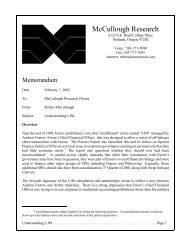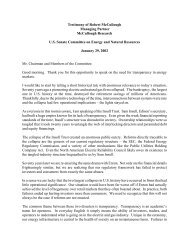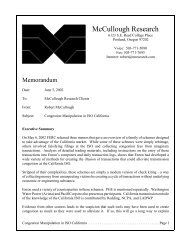Prepared Direct Testimony of Robert McCullough on Behalf of the ...
Prepared Direct Testimony of Robert McCullough on Behalf of the ...
Prepared Direct Testimony of Robert McCullough on Behalf of the ...
Create successful ePaper yourself
Turn your PDF publications into a flip-book with our unique Google optimized e-Paper software.
Page 19 <str<strong>on</strong>g>of</str<strong>on</strong>g> 76SEATAC-400each time period. Some plants are "available" and c<strong>on</strong>tribute <strong>the</strong>ir total capacity to this sum,while o<strong>the</strong>rs are "unavailable" and add zero.Fourth, <strong>the</strong> statistical distributi<strong>on</strong> <str<strong>on</strong>g>of</str<strong>on</strong>g> <strong>the</strong> variable <str<strong>on</strong>g>of</str<strong>on</strong>g> interest is evaluated. In our applicati<strong>on</strong>, wehave a particular interest in <strong>the</strong> probability that <strong>the</strong> total available capacity is less than someparticular proporti<strong>on</strong> <str<strong>on</strong>g>of</str<strong>on</strong>g> <strong>the</strong> total possible capacity. As a statistical statement, we are looking for<strong>the</strong> value <str<strong>on</strong>g>of</str<strong>on</strong>g> a probability distributi<strong>on</strong> functi<strong>on</strong> at a particular availability percentage.Q. Are <strong>the</strong>re o<strong>the</strong>r problems that clearly illustrate how this approach works in evaluating<strong>the</strong> likelihood <str<strong>on</strong>g>of</str<strong>on</strong>g> complex events?A. An analogous problem is <strong>the</strong> questi<strong>on</strong> <str<strong>on</strong>g>of</str<strong>on</strong>g> how likely it is to roll ten dice simultaneously, assign avalue <str<strong>on</strong>g>of</str<strong>on</strong>g> zero to a die if it comes up six and a value <str<strong>on</strong>g>of</str<strong>on</strong>g> <strong>on</strong>e o<strong>the</strong>rwise, add up <strong>the</strong> values and get atotal less than or equal to five. This problem can be solved analytically, but is easily explored byjust throwing ten dice many times and tabulating <strong>the</strong> results. The problem is more difficult tosolve analytically if <strong>the</strong> dice have different numbers <str<strong>on</strong>g>of</str<strong>on</strong>g> faces - e.g. a mix <str<strong>on</strong>g>of</str<strong>on</strong>g> normal cubical dice,octrahedral dice, tetrahedral dice - and <strong>the</strong> values assigned to each die are different functi<strong>on</strong>s <str<strong>on</strong>g>of</str<strong>on</strong>g>how <strong>the</strong> die falls, and if <strong>the</strong>re are many more dice. In that case, a c<strong>on</strong>vincing dem<strong>on</strong>strati<strong>on</strong> canstill be made by actually c<strong>on</strong>ducting <strong>the</strong> experiment, throwing <strong>the</strong> dice many tirnes and keepingtabs <strong>on</strong> <strong>the</strong> results.Q. How would this roll-<str<strong>on</strong>g>of</str<strong>on</strong>g>-<strong>the</strong>-dice example relate to <strong>the</strong> study you performed?A. The capacity availability M<strong>on</strong>te Carlo study we performed involved ten thousand ''throws <str<strong>on</strong>g>of</str<strong>on</strong>g> <strong>the</strong>dice."Q. How likely would <strong>the</strong> real world capacity availability for <strong>the</strong>se plants be if <strong>the</strong> simple
















